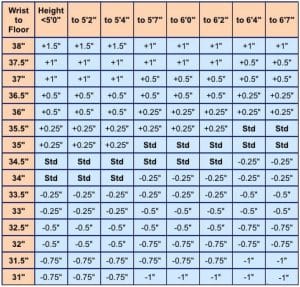Have you ever stood amidst a sea of golf clubs, feeling utterly adrift while pondering the eternal question: steel or graphite shafts? Choosing between these two options can be as perplexing as deciding between a lakeside villa and a mountain retreat. While both will get the job done, each type of shaft offers its own advantages and quirks that could substantially affect your game. The conundrum facing many golfers, both novices and seasoned veterans alike, revolves around identifying which club shaft material best aligns with their style of play.
The Evolution of Golf Shafts
Understanding the technological evolution of golf shafts is essential to making an informed decision. Initially, golf club shafts were predominantly crafted from hickory wood until the introduction of steel shafts in the 1920s. This marked a significant shift in technology, bringing greater precision and stability to the game.
Steel shafts were the leading choice for many decades due to their robustness and consistency. However, with advancements in materials engineering, the 1970s saw the emergence of graphite shafts, offering a lighter and more flexible alternative. This innovation introduced a new paradigm in golfing technology, allowing for greater customization and adaptation to individual playing styles.
Understanding Steel Shafts
Composition and Structure
Steel shafts are typically constructed using carbon steel or stainless steel, which contributes to their inherent strength and durability. The method of construction usually involves either mechanical seamless tubing or welded tubing, which guarantees a high level of consistency and uniformity in each shaft produced.
Benefits of Steel Shafts
One of the primary advantages of steel shafts is their level of control. Because they are heavier than graphite shafts, they naturally result in lower torque and less flex, which can enhance precision in a player’s swing. This reduction in twisting is particularly beneficial when it comes to accuracy, making steel shafts a favored choice among professional golfers who prioritize control over distance.
Additionally, steel shafts are renowned for their durability. They are less prone to breakage or wear, making them a cost-effective investment for players who frequently hit the links. Not to mention, they offer superior feedback, allowing golfers to get a better sense of their swings and adjust accordingly.
Who Should Use Steel Shafts?
Steel shafts are often recommended for players with faster swing speeds who require the additional weight to leverage power and control. They are especially suitable for players who are more experienced and have developed a consistent, strong swing. Furthermore, steel shafts are ideal for those who play regularly, given their durability and resistance to wear and tear.

Exploring Graphite Shafts
Composition and Structure
Graphite shafts are composed of a mix of materials, typically carbon fiber combined with resin. This combination offers a lighter structure while maintaining the required strength. The shafts are produced through a complex process known as filament winding or sheet wrapping, which involves layering the graphite in specific patterns to achieve the desired shaft characteristics.
Benefits of Graphite Shafts
The most significant advantage of graphite shafts is their lightweight nature. The reduction in weight allows for increased swing speed, which can lead to longer distances. This characteristic is particularly beneficial for golfers with slower swing speeds or those looking to add extra yards to their game.
Graphite shafts also offer greater vibration dampening, providing a softer feel upon impact. This can be especially appealing for players with joint pain or those who prefer a more cushioned experience.
Who Should Use Graphite Shafts?
Players looking for additional distance will find graphite shafts most beneficial. They are especially favorable for senior golfers, women, and juniors who might have slower swing speeds and could benefit from the added yardage. Additionally, those experiencing physical discomfort during play might prefer graphite for its shock-absorbing qualities.
Steel vs. Graphite: A Head-to-Head Analysis
Below is a side-by-side comparison that highlights the primary differences between steel and graphite shafts:
| Feature | Steel Shafts | Graphite Shafts |
|---|---|---|
| Weight | Heavier | Lighter |
| Flexibility | Less flexible | More flexible |
| Control | High due to less torque | Moderate, more torque |
| Distance | Less distance but greater accuracy | More distance with potentially less accuracy |
| Feedback | Superior feedback for swing analysis | Dampened feedback |
| Durability | Highly durable | Moderate durability |
| User | Suited for faster swing speeds | Suited for slower swing speeds |

Performance Factors in Choosing Shafts
Swing Speed
The predominant factor influencing the choice between steel and graphite shafts is swing speed. A golfer with a fast swing might struggle with the additional flexibility inherent in graphite, leading to variability and less control. Conversely, a golfer with a slower swing might benefit from the increased speed and distance graphite shafts offer.
Ball Flight and Trajectory
Graphite shafts generally provide a higher ball flight, making them beneficial for players aiming to get more loft on their shots. On the other hand, steel shafts contribute to a flatter trajectory with a focus on precision rather than height.
Feel and Feedback
Steel shafts offer more feedback, allowing players to sense the exact position of the club throughout the swing, enabling better correction and adjustment. In contrast, graphite’s vibration dampening quality reduces feedback, which might be preferred by golfers seeking enhanced comfort over detailed swing analysis.
Considerations for Custom Fitting
Personal Sensitivity to Weight
Some golfers are sensitive to the weight of their clubs. If swinging a heavier steel shaft feels cumbersome, switching to a lighter graphite shaft may provide more comfort and improved performance.
Physical Condition
Golfers prone to joint discomfort or injuries may find graphite’s shock-absorbing properties essential. The reduction in vibration and lighter weight can alleviate physical strain, preserving the joy of playing.
Cost Implications
While traditionally more expensive, the cost of graphite shafts has become more competitive. Nonetheless, steel shafts are often more economically viable, especially for players looking for durability and longevity without the added expense.

Choosing the Right Shaft for Your Game
Navigating the decision between steel and graphite involves understanding the nuances of your own game. Consider taking a moment to evaluate your priorities on the course: distance versus precision, comfort versus feedback, or durability versus cost.
Ultimately, reaching a decision might require a professional fitting session. As every golfer is different, having a seasoned expert analyze your swing mechanics and offer personalized recommendations could be the key to unlocking your full potential on the green.
Conclusion
While both steel and graphite shafts have their merits, the deciding factor often comes down to personal preference and playing style. Each golfer must weigh the importance of factors such as control, distance, durability, and comfort. Much like selecting a well-tailored suit, choosing the right shaft material can dramatically impact your performance and enjoyment of the game.
In the end, whether you opt for the steadfast feel of steel or the lightweight advantage of graphite, the right shaft is the one that makes the game more enjoyable and rewarding for you personally. With this in-depth analysis, you are now better equipped to assess which shaft will optimize your game, allowing you to stride confidently onto the fairway knowing you have made an informed choice.











